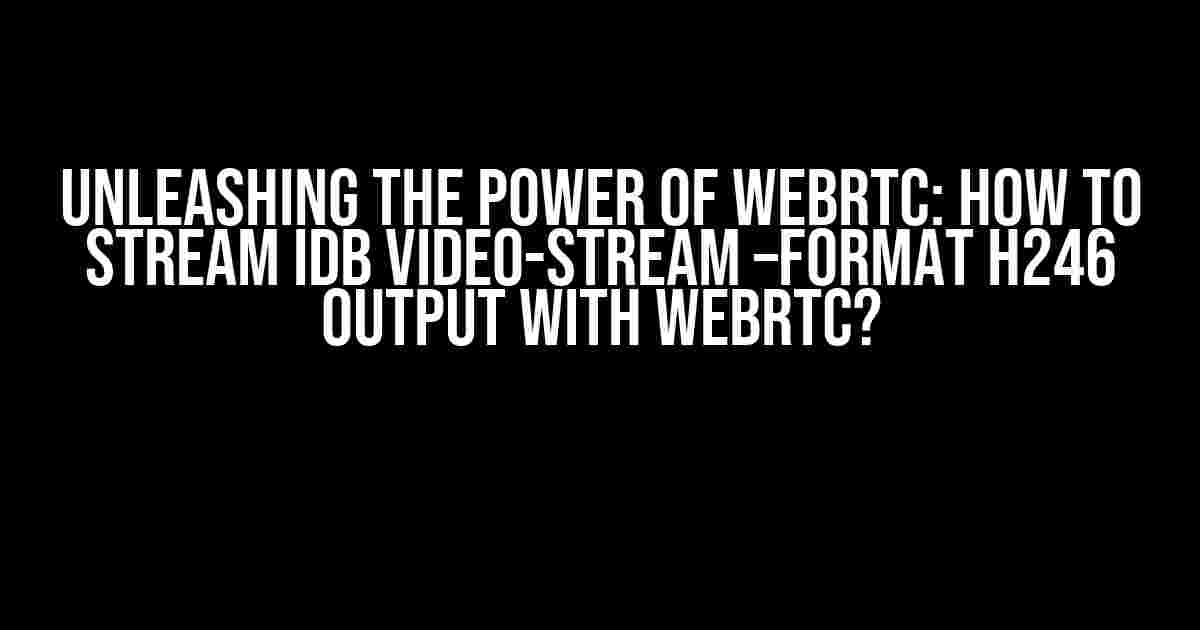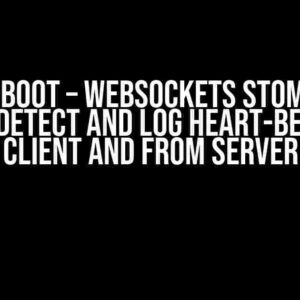Are you tired of struggling to stream high-quality video content to your audience? Do you want to unlock the full potential of WebRTC and take your video streaming to the next level? Look no further! In this comprehensive guide, we’ll walk you through the step-by-step process of streaming IDB video-stream –format h246 output with WebRTC. Buckle up, and let’s dive in!
- What is WebRTC?
- Streaming IDB Video-Stream –format h246 Output with WebRTC: A Step-by-Step Guide
- Step 1: Set Up Your Development Environment
- Step 2: Install Required Dependencies
- Step 3: Create a Basic WebRTC PeerConnection
- Step 4: Create a Video Stream
- Step 5: Add the Video Stream to the PeerConnection
- Step 6: Configure the IDB Video-Stream –format h246 Output
- Step 7: Stream the IDB Video-Stream –format h246 Output with WebRTC
- Conclusion
What is WebRTC?
Before we dive into the nitty-gritty of streaming IDB video-stream –format h246 output with WebRTC, it’s essential to understand what WebRTC is. WebRTC (Web Real-Time Communication) is an open-source project that enables real-time communication between browsers, allowing for peer-to-peer video conferencing, file transfer, and screen sharing.
Why Use WebRTC for Video Streaming?
WebRTC offers several advantages for video streaming, including:
- Low latency: WebRTC enables real-time communication, allowing for faster video streaming and reduced latency.
- High-quality video: WebRTC supports high-definition video streaming, making it ideal for applications that require crystal-clear video.
- Security: WebRTC provides end-to-end encryption, ensuring that your video streams are secure and protected from unauthorized access.
- Scalability: WebRTC allows for effortless scaling, making it easy to handle large volumes of video streams.
Streaming IDB Video-Stream –format h246 Output with WebRTC: A Step-by-Step Guide
Now that we’ve covered the basics of WebRTC, let’s dive into the process of streaming IDB video-stream –format h246 output with WebRTC.
Step 1: Set Up Your Development Environment
To get started, you’ll need to set up your development environment. Install Node.js, and then create a new project folder. Inside the project folder, create a new file called `index.html` and another file called `server.js`.
mkdir webrtc-streaming
cd webrtc-streaming
npm init -y
touch index.html server.jsStep 2: Install Required Dependencies
Next, you’ll need to install the required dependencies for your project. Install the `webrtc` package using npm.
npm install webrtcStep 3: Create a Basic WebRTC PeerConnection
In `server.js`, create a basic WebRTC peer connection. This will enable real-time communication between the client and server.
const { RTCPeerConnection, RTCSessionDescription } = require('webrtc');
const pc = new RTCPeerConnection({
iceServers: [
{
urls: 'stun:stun.l.google.com:19302'
}
]
});Step 4: Create a Video Stream
In `index.html`, create a video stream using the `getUserMedia` API. This will allow the user to grant access to their camera and microphone.
<video id="local-video" autoplay playsinline></video>
<script>
navigator.mediaDevices.getUserMedia({ video: true, audio: true })
.then(stream => {
document.getElementById('local-video').srcObject = stream;
})
.catch(error => {
console.error('Error accessing media devices:', error);
});
</script>Step 5: Add the Video Stream to the PeerConnection
Add the video stream to the peer connection using the `addStream` method.
pc.addStream(stream);
// Create an offer
pc.createOffer()
.then(offer => {
return pc.setLocalDescription(new RTCSessionDescription({ type: 'offer', sdp: offer }));
})
.then(() => {
// Send the offer to the server
socket.emit('offer', pc.localDescription);
})
.catch(error => {
console.error('Error creating offer:', error);
});Step 6: Configure the IDB Video-Stream –format h246 Output
In `server.js`, configure the IDB video-stream –format h246 output using the `ffmpeg` command.
const ffmpeg = require('fluent-ffmpeg');
// Assume "input.mp4" is the input file
const command = ffmpeg()
.input('input.mp4')
.outputOptions('-c:v libx264', '-crf 18', '-c:a aac', '-b:a 128k')
.output('output.h246');
command.on('end', () => {
console.log('IDB video-stream --format h246 output generated successfully!');
});Step 7: Stream the IDB Video-Stream –format h246 Output with WebRTC
Finally, stream the IDB video-stream –format h246 output with WebRTC using the `webrtc` package.
const { RTCPeerConnection, RTCSessionDescription } = require('webrtc');
// Assume "output.h246" is the generated IDB video-stream --format h246 output file
const stream = fs.createReadStream('output.h246');
const pc = new RTCPeerConnection({
iceServers: [
{
urls: 'stun:stun.l.google.com:19302'
}
]
});
pc.addStream(stream);
// Create an offer
pc.createOffer()
.then(offer => {
return pc.setLocalDescription(new RTCSessionDescription({ type: 'offer', sdp: offer }));
})
.then(() => {
// Send the offer to the client
socket.emit('offer', pc.localDescription);
})
.catch(error => {
console.error('Error creating offer:', error);
});Conclusion
And that’s it! You’ve successfully streamed IDB video-stream –format h246 output with WebRTC. With this comprehensive guide, you should now have a solid understanding of how to harness the power of WebRTC for high-quality video streaming.
Remember to test your code thoroughly and optimize it for your specific use case. Happy coding!
| Keyword | Description |
|---|---|
| WebRTC | A open-source project that enables real-time communication between browsers. |
| IDB | Interleaved Dynamic Bitrate, a format for video streaming. |
| h246 | A video codec used for high-quality video compression. |
By following this guide, you’ll be able to unlock the full potential of WebRTC and take your video streaming to the next level. So, what are you waiting for? Get started today and experience the power of WebRTC!
Do you have any questions or need further clarification on any of the steps? Feel free to ask in the comments below!
Frequently Asked Question
Get ready to dive into the world of video streaming with WebRTC and H.246! If you’re looking for answers on how to stream IDB video-stream with the –format H.246 output using WebRTC, you’re in the right place. Below, we’ve got the most frequently asked questions and answers to get you started.
What is WebRTC and how does it relate to video streaming?
WebRTC (Web Real-Time Communication) is an open-source project that enables real-time communication capabilities to be built into web browsers and mobile applications. It’s a game-changer for video streaming, allowing for peer-to-peer communication and reducing the need for intermediaries. In the context of streaming IDB video-stream with H.246 output, WebRTC provides a robust and efficient way to transmit high-quality video in real-time.
What is the –format H.246 output, and why is it important for video streaming?
The –format H.246 output refers to the video compression standard used to encode video data. H.246 is a widely adopted standard for high-quality video compression, offering a great balance between video quality and file size. When streaming IDB video-stream with H.246 output, you can expect a high-quality, low-latency video experience that’s perfect for real-time communication and streaming applications.
How do I set up WebRTC to stream IDB video-stream with H.246 output?
To set up WebRTC for streaming IDB video-stream with H.246 output, you’ll need to follow these general steps: Install and configure a WebRTC-compatible browser or application; Set up your IDB video-stream source; Configure your WebRTC peer connection to use the H.246 video codec; Establish a peer connection and start streaming! For more detailed instructions, check out the WebRTC documentation and IDB video-stream guidelines.
What are some common challenges when streaming IDB video-stream with H.246 output using WebRTC?
Some common challenges when streaming IDB video-stream with H.246 output using WebRTC include: Ensuring compatible browser or application versions; Managing video bitrate and quality settings; Handling network congestion and latency issues; and Overcoming browser or platform-specific limitations. To overcome these challenges, make sure to test your setup thoroughly and fine-tune your configuration for optimal performance.
What are some popular use cases for streaming IDB video-stream with H.246 output using WebRTC?
Some popular use cases for streaming IDB video-stream with H.246 output using WebRTC include: Live video conferencing and online meetings; Real-time video surveillance and monitoring; Interactive live streaming for e-sports, entertainment, and education; and Virtual event and conference platforms. With WebRTC and H.246, the possibilities are endless!



